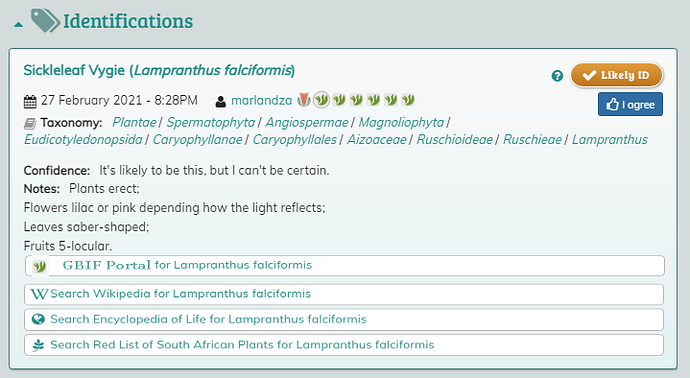Testing GBIF South Africa
Mike - I’ve added a tag as a test and am linking some observations to see if they match.
Here is one and the GBIF tag should link to the others I’ve done
Thanks for that would be useful to hear about your testing as we need to update that dictionary as soon as we have sorted out the UK one. Perhaps best to email me directly as I could also put you in touch with programmer when he starts working on that part of the update
Yes, but it is only a Tag bringing chosen Observations together. It is not a link to the GBIF Portal.
I have been adding direct GBIF links to observations for years. But only in Description, as they are disallowed in ID Notes
A GBIF link should be in the External Links in iSpotza ID Panel (along with NBN, or replacing it, in the UK)
Mike, thanks - it’s most likely better than what we have now, they seem to support older works that never had vars and subspecies. Possibly our older iSpot obs that were lost, due to dictionary updates, would reappear.
I see that they have some good links which may help with choosing a subspecies, but it would be so nice to not have to choose and yet be able to post.
Not a lot of folks will want to spend time on this.
Slowly, slowly - we’ll get there.
This one has a subsp.
I’ve added the GBIF link as well as a specimen link here.
Remember not all iNat IDs are correct and very seldom do they come with logic for choice - a bit like Facebook - ‘Like and Agree’. Then maybe I’m biased.
Yes, it is one of the worse things about iNat. I got into trouble challenging a Curator about careless and inappropriate agreeing. She suggested I leave!
With a competitive league for the Most Agreements (Top Identifier), it is bound to lead to issues. Further, one (any old) agreement means Research Grade - that is a laugh!
Worse, is that iNat RGs get into GBIF, so I usually filter OUT iNat results. Spoils my appetite!
really sad, there are so many good contributions/ors - it shouldn’t be a competition - why I didn’t follow the herd, I think makes sense?
I’m still learning how to use this site - must see how to filter- maybe leave some like Nick Helm and Nicky vB. and the Batses (sp?)
This is really weird
Check these three observations:
My latest posted today and iSpot autofilled
Found this searching for Arctotis breviscapa and linked
But this one is lost -
Can you work your magic here Derek?
Looks as if the first one was not clicked from the dropdown. But main question here is whether the two species A. breviscapa and A. leptorhiza are actually the same, the dictionary implies not
Thanks Mike - first posted Added 21 September 2011, early days which may be the case - I’m surprised that Tony didn’t comment at the time.
Definitely both names here https://eol.org/pages/6205939/names.
But we’ve spent enough time on this for the moment.
Letting go.
M
Another one that I think Derek would enjoy
Saw that there was no link and BLACK print so I’ve allowed iSpot to select a name for me.
How do we know who is/was responsible for these changes?
I haven’t checked GBIF - but have added links to the Red List, their note and Strelitzia 29 (2012) where E, longifolius still prevails and this was credited to M. Koekemoer.
Unresolved name
Keep y’r eye on up-to-date conflicting and confusing taxonomy
https://compositae.org/aphia.php?p=taxdetails&id=1180622
and https://www.catalogueoflife.org/data/taxon/39F29
and https://www.gbif.org/species/3145341
and https://www.gbif.org/species/3145340
and http://www.theplantlist.org/tpl/record/gcc-127806
Etc…The world Authority probably looks to iNat https://www.inaturalist.org/observations/38070102 (taxon swapping)
Looking at the iNat link you give - Corinne made the suggestion, And then the shepherd and the sheep followed.
In the latest Goldblatt and Manning 2012 (text page 344) - https://www.sanbi.org/sites/default/files/documents/documents/strelitzia-29-2012.pdf
The same fellow, Koekemoer, has just done this section
ASTERACEAE
Amphiglossa, Elytropappus and Stoebe with M. Koekemoer
AND Redlist has it right this time
In an unpublished revision, E. longifolius is lumped together with three other taxa into one widespread species, Myrovernix muricata (Sprgl. ex Sch.Bip.) Koekemoer (Koekemoer 2002). Distribution in this assessment is according to Goldblatt and Manning (2000).
http://redlist.sanbi.org/species.php?species=3029-10
SO which route will iSpot follow ? and meanwhile is my plant correct, whichever way we go.
Looks as if it might be the same as the one from TR iNat in your example more or less the same location.
Thought you’d like this one Derek.

